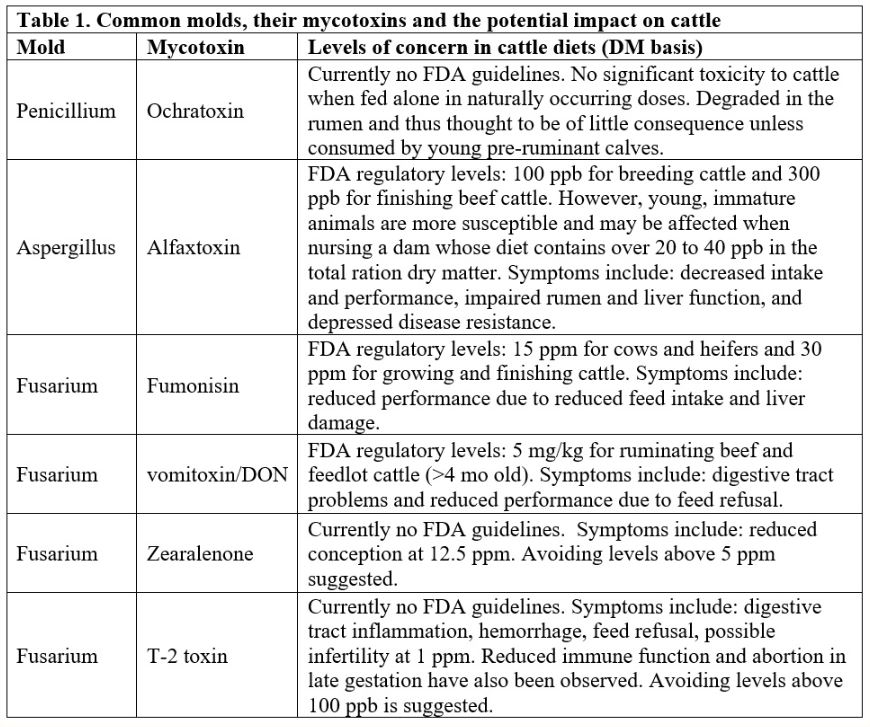Do You Have Mold and Mycotoxins in Your Silage?

We typically suggest getting forage tested to determine nutrient content such as energy and protein. But with silage, additional testing may be needed, especially when grown under stressed conditions and/or put up in less-than-ideal conditions. The presence of mold in silage can decrease the energy value, feed intake, and performance of cattle. Additionally, some molds produce harmful mycotoxins that can impact animal production and health.
Field molds can be an issue in cereal grain crops, including Gibberella, Aspergillus and Fusarium. These molds grow out in the field, and some can remain after harvest. Aspergillus is more likely to be present in drought conditions and thus, may be an issue this year. Aspergillus is a yellow to green mold that can produce mycotoxins (Table 1). Unfortunately, you can have no live field mold present after fermentation but still have the mycotoxins they produced in the field present. This is because once produced, most of these toxic compounds are not destroyed by heat, time, or fermentation. Thus, if you see mold at harvest, it may be a good idea to test for mycotoxins. A basic mycotoxin screening will cost around $170 with individual mycotoxin tests costing around $55.
Storage molds can be a big issue in silage that was put up too dry and this can be amplified if there was poor initial packing. Molds require oxygen from air to grow. Regardless of moisture at packing, uncovered piles are also likely to have increased risk of high mold counts. Common storge molds which tend to grow in silage include: Penicillium, Aspergillus and Monascus.
The primary feeding concerns related to storage molds are reduced silage nutritional quality, bunk life and palatability. Mold counts can help to determine how much storage mold is present and an identification can help to see if you might have the potential for toxins lurking in your silage. A mold and yeast count with identification typically costs around $30 to $45. Depressed digestibility (reduced energy availability) can occur with mold counts greater than 100,000 colony-forming units (cfu) per gram of DM even without mycotoxins present. At 300,000 cfu/g of DM, caution is advised as this can result in reduced feeding value, reduced intake, reduced performance and digestive issues.
Unfortunately, high mycotoxin levels can be found with low mold counts. This is because the amount of mycotoxin produced by mold depends on growing conditions. Unfortunately, not all mycotoxins can be detected in routine testing by commercial laboratories and not all laboratories will test for molds and mycotoxins. Many dairy focused labs such as Dairyland labs, Dairy One, and Cumberland Valley Analytical Services, etc. will do mold counts, mold identification and mycotoxin testing.
If storage mold is present, then feed out rate is even more important. Make sure to feed enough that you remove at least 6 inches per day off the face, with 12 inches being more ideal. Also, do not pull off more than 1 feeding at a time. Mold will start to grow rapidly when exposed to oxygen. A tremendous amount of mold can grow in less than 24 hours. This can significantly reduce the feeding value and increase the risk of negative effects on the cattle being fed.
The safe level of mycotoxin is hard to establish as symptoms are often nonspecific and may be wide-ranging. Symptoms result from a progression of effects, or opportunistic diseases, making a diagnosis difficult. Symptoms vary depending on the mycotoxins involved and their interactions with other mycotoxins and stress factors. Table 1 provides the current regulatory guidelines (if any), concentrations at which symptoms have been observed and the potential effect of common mycotoxins. However, it should be noted that contaminated feeds often contain multiple mycotoxins, potentially amplifying the expected effects. In general, young calves and stressed animals are most susceptible to mycotoxins.
While not perfect, mold spore counts and mold identification, coupled with mycotoxin testing if warranted, can be helpful to evaluate if there is a risk of negative effects when feeding silage. This is especially true, for silages that were grown or harvested in less-than-ideal conditions. Understanding the amounts of mold and mycotoxins present can help with deciding which classes of cattle to feed and how much silage can safely be included in the diet.








